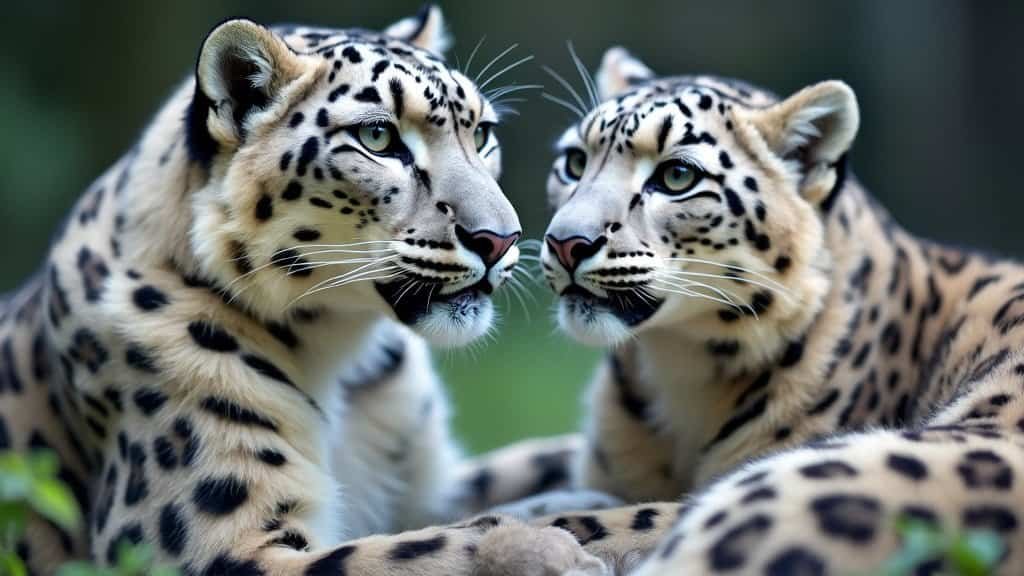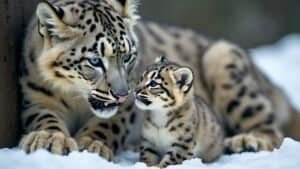Introduction
Understanding the behavioral differences between male and female snow leopards provides valuable insights into their survival strategies in the harsh mountainous environments they inhabit. These majestic big cats exhibit distinct behaviors that are shaped by their roles in the ecosystem, their physical traits, and their social interactions
This article delves into key areas such as territorial marking, parenting roles, hunting tactics, and social behaviors, highlighting how these differences contribute to the survival and adaptation of snow leopards in the wild
We’ll explore how gender influences not only the daily activities of these animals but also their broader interactions within their species
Territorial Behavior Of Male And Female Snow Leopards
Territorial behavior is a crucial aspect of snow leopard survival, influencing their ability to hunt, reproduce, and avoid conflicts
Male and female snow leopards display distinct patterns of territory marking, boundary establishment, and interactions with other leopards. These differences are shaped by their roles in reproduction, physical attributes, and ecological needs
How Males Mark Territory
Male snow leopards are known for their extensive and aggressive territorial marking. They establish larger territories than females, often encompassing the ranges of multiple females
Males mark their territories using a combination of scent marking, including spraying urine on rocks and vegetation, and physical markers such as scratch marks on trees and the ground. This behavior serves as a signal to other males to avoid the area and as a way to attract potential mates within their territory
The size of a male’s territory can be vast, often spanning hundreds of square miles, depending on prey availability and the density of other males in the region
A study conducted by the Snow Leopard Trust found that male territories can overlap with those of several females, allowing the male to maintain contact with multiple potential mates. This territorial overlap with females is strategic, as it increases the male’s chances of successful mating during the breeding season
Female Territorial Boundaries
In contrast, female snow leopards maintain smaller territories that are more focused on areas with abundant prey to support themselves and their cubs. The primary concern for a female is securing a safe and resource-rich environment where she can raise her cubs. Female territories are usually adjacent to each other, with less overlap compared to males
Females also mark their territories but with less intensity than males. Their markings are more about maintaining boundaries and ensuring the safety of their offspring rather than attracting mates
These territories are fiercely defended during the cub-rearing period, with females becoming more aggressive towards intruders, including other females
Territorial Disputes And Encounters
While both male and female snow leopards are generally solitary, territorial disputes can occur, especially among males
Such encounters are typically rare but can be intense, involving vocalizations, displays of strength, and sometimes physical confrontations. Males are more likely to engage in these disputes as they seek to expand or defend their large territories
Females, on the other hand, are less likely to engage in direct confrontations unless their cubs are threatened. During the cub-rearing period, females may avoid areas where male snow leopards are frequently present to protect their young from potential harm
Interestingly, while males may roam widely across their territories, females are more likely to remain within the core areas of their range, focusing on safety and access to food
Parenting Roles And Social Interactions
Parenting and social interactions among snow leopards reveal significant differences between males and females, particularly in how they contribute to raising offspring and interacting with others of their species
These behaviors are driven by the distinct roles each gender plays in the life cycle of snow leopards, especially concerning cub rearing and social bonds
Female Snow Leopard Parenting Duties
Female snow leopards bear the primary responsibility for raising cubs, a role that requires significant energy and resources
After a gestation period of approximately 90-100 days, a female gives birth to a litter of 1 to 3 cubs, usually in a secluded den. The location of the den is carefully chosen to ensure protection from predators and harsh weather conditions
During the early months of a cub’s life, the mother provides constant care, feeding the cubs with milk and later transitioning them to solid food as she brings back prey from hunts. The first few months are critical, as the cubs are entirely dependent on their mother for survival
The female teaches her cubs essential survival skills, such as hunting techniques and how to navigate the rugged terrain. This period of maternal care typically lasts for 18 to 22 months, after which the cubs become independent
Male Involvement In Cub Raising
Unlike females, male snow leopards do not participate in the direct raising of cubs. Once mating occurs, males typically disengage from the female and play no role in the nurturing or protection of the offspring
This absence of paternal involvement is typical among solitary big cats, where males focus on maintaining and defending their territory rather than engaging in family life
However, the presence of a strong male territory can indirectly benefit the cubs. A dominant male’s territory provides a relatively safe environment for the female to raise her young, reducing the risk of infanticide by rival males
This indirect protection is crucial, especially in regions where the snow leopard population density is low, and encounters with other males are rare but potentially deadly for cubs
Social Bonds Among Female Snow Leopards
While snow leopards are generally solitary, females may develop temporary social bonds, particularly with their offspring and, occasionally, with other females. These bonds are most evident during the cub-rearing period when a mother may share her hunting knowledge and protective behaviors with her young
In some cases, related females, such as sisters or a mother and daughter, may maintain overlapping territories and exhibit tolerance towards each other. This tolerance can extend to mutual grooming, playing, and even cooperative hunting in rare instances
Such interactions, though not as common as in other social big cats like lions, suggest that female snow leopards can exhibit a degree of sociality when it benefits their offspring’s survival
Hunting And Feeding Behavior
Hunting and feeding behaviors among male and female snow leopards are shaped by their physical differences and the distinct ecological roles each plays within their environment
These differences in behavior are critical to understanding how each gender adapts to the challenges of their harsh, mountainous habitats
Hunting Strategies Of Male Snow Leopards
Male snow leopards, typically larger and more robust than females, exhibit hunting strategies that capitalize on their strength and size
They often target larger prey, such as blue sheep (bharal) or Siberian ibex, which are abundant in the snow leopard’s range. A male’s ability to take down larger prey is essential for maintaining his energy levels, given the extensive territories they patrol and defend
Males usually hunt alone and use their powerful limbs and agility to ambush prey from above, often leaping down from a higher vantage point to surprise their target. This ambush style is a hallmark of snow leopard hunting behavior, enabling them to take advantage of the rugged terrain that characterizes their habitat
Once a kill is made, males may consume their prey over several days, often dragging the carcass to a secluded spot to avoid scavengers and to eat in relative safety
Female Hunting Tactics
Female snow leopards, while also adept hunters, often focus on smaller prey compared to males, particularly when they have cubs to care for
The necessity to feed their young, coupled with the smaller size of females, influences their choice of prey. Females frequently target smaller ungulates, such as Himalayan tahr or young blue sheep, which are easier to subdue and transport back to their cubs
The hunting strategies of females are often more cautious and calculated, reflecting the need to conserve energy for cub-rearing activities. Females with cubs may also hunt more frequently to meet the increased nutritional demands of their growing offspring
Additionally, female snow leopards may exhibit greater flexibility in their hunting grounds, sometimes venturing closer to human settlements where smaller prey like livestock might be available, although this increases the risk of conflict with humans
Differences In Prey Selection
The differences in prey selection between male and female snow leopards are largely a reflection of their physical attributes and reproductive roles
Males, with their larger body mass, can tackle bigger and more challenging prey, which provides them with the necessary energy to sustain their territorial activities. On the other hand, females prioritize prey that can be quickly and efficiently hunted, ensuring they can return to their cubs without delay
These behavioral differences are not just about individual survival but also about ensuring the continued survival of their species
By targeting different types of prey, males and females reduce intraspecific competition for food, allowing both genders to coexist within overlapping territories without depleting local prey populations
Solitary And Social Behavior
Snow leopards are primarily solitary animals, but their solitary and social behaviors exhibit notable differences between males and females. These behaviors are closely tied to their reproductive roles, territorial needs, and interactions with other snow leopards
Solitude In Male Snow Leopards
Male snow leopards are generally more solitary than females, driven by their need to patrol and defend large territories. A male’s solitary behavior is largely influenced by the vastness of his territory, which often covers several hundred square miles
This need for solitude ensures that males can effectively monitor their domain, mark their boundaries, and minimize encounters with rival males, which could lead to dangerous confrontations
Male snow leopards typically only seek out social interactions during the mating season. Outside of this period, they avoid other snow leopards, focusing instead on maintaining their territory and hunting
This solitude is a key survival strategy, allowing males to conserve energy for defending their range and pursuing mates
Female Snow Leopard Social Structures
Female snow leopards, while also solitary, display more social behavior, particularly during the cub-rearing period. The need to protect and nurture their cubs leads to a temporary breakdown of their solitary lifestyle, as they maintain close and constant contact with their offspring
During this time, the female’s primary focus is on the safety and development of her cubs, which may involve teaching them survival skills, such as hunting and navigating their rugged environment
Unlike males, females may also exhibit social tolerance towards other snow leopards, especially their offspring from previous litters. This tolerance can sometimes extend to other females, particularly if they are related or if their territories overlap
Such social structures, though not as pronounced as in more social big cat species like lions, suggest that female snow leopards are capable of forming bonds that go beyond the typical solitary behavior of their species
Interaction During Mating Season
The mating season is the primary time when both male and female snow leopards engage in social interactions
During this period, which typically occurs between January and March, males and females temporarily come together for courtship and mating. This period of social interaction is brief, lasting only a few days to a couple of weeks
During the mating season, males will actively search for receptive females within their territory, often following scent markings left by the females. The courtship involves vocalizations, scent marking, and physical interactions that facilitate mating. After mating, the male usually leaves, returning to his solitary lifestyle, while the female begins preparing for cub rearing
These interactions highlight the stark differences in the social behaviors of male and female snow leopards, driven by their distinct biological and ecological roles
While both genders are largely solitary, their interactions during the mating season and, in the case of females, during cub-rearing, underscore the complex social dynamics that exist within this species
Physical Differences And Their Impact On Behavior
The physical differences between male and female snow leopards play a significant role in shaping their behaviors, particularly in areas like hunting, territoriality, and social interactions
Understanding these physical distinctions provides deeper insights into the unique behavioral patterns observed in each gender
Size And Strength Comparison
One of the most notable physical differences between male and female snow leopards is their size. Males are generally larger and heavier than females, with an average weight of 100-120 pounds, while females typically weigh between 60-90 pounds
This size difference is also reflected in their length, with males measuring up to 7.5 feet from head to tail, compared to the smaller, more compact female
This size and strength disparity has direct implications for their behavior. Males, with their greater muscle mass, are more capable of taking down larger prey and defending extensive territories. Their physical prowess enables them to confront rivals more effectively, which is crucial for maintaining dominance in their range
How Physical Traits Influence Hunting
The physical traits of male and female snow leopards influence their hunting strategies. As larger animals, males have the advantage of strength, allowing them to pursue and subdue bigger prey, such as ibex and argali sheep
This capability not only sustains their larger body size but also supports their energetic needs as they patrol and defend vast territories
Females, on the other hand, while still powerful hunters, tend to target smaller prey. Their more compact build allows for greater agility and stealth, which is advantageous when hunting in the steep, rugged terrain of their habitat
Females are often more cautious hunters, as their primary concern is to return safely to their cubs. Their lighter frame also makes it easier to navigate and hunt in areas where large males might struggle
Impact Of Size On Territorial Behavior
The difference in size between males and females also influences their territorial behavior. Males, being larger and stronger, are more equipped to establish and defend larger territories
This territorial dominance is essential for gaining access to multiple females during the mating season, thereby increasing their reproductive success. The larger a male’s territory, the more resources it contains, which can support not only the male but also any females residing within his range
Females, however, do not require as extensive a territory. Their smaller ranges are often more focused on areas with high prey density, which is critical for raising cubs
The need for a safe and resource-rich environment to nurture their young means that females are less likely to engage in territorial expansion and more focused on defending a well-established, secure area
These physical differences between males and females are not just matters of size and strength but are intricately linked to their roles within the species. Each gender’s unique physical attributes have evolved to optimize their survival and reproductive success in the challenging environments they inhabit
Conclusion
Male and female snow leopards exhibit a range of behavioral differences that are deeply influenced by their physical characteristics, ecological roles, and reproductive strategies
Males, typically larger and stronger, maintain extensive territories and focus on securing and defending their range, often engaging in aggressive territorial marking and targeting larger prey. Females, on the other hand, are more focused on nurturing and raising cubs, with behaviors that emphasize safety, resource availability, and the well-being of their offspring
The differences in hunting strategies, social behaviors, and territoriality between the genders highlight the unique adaptations that each has developed to thrive in their harsh, mountainous environments
Understanding these distinctions is crucial for conservation efforts, as it provides insights into the specific needs and challenges faced by each gender in the wild. Protecting the delicate balance between male and female behaviors is essential for ensuring the long-term survival of this elusive and endangered species













